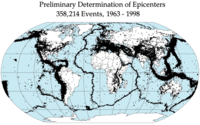
Photo from wikipedia
Author(s): Zbinden, D; Rinaldi, AP; Urpi, L; Wiemer, S | Abstract: ©2017. American Geophysical Union. All Rights Reserved. Induced seismicity due to natural gas production is observed at different sites… Click to show full abstract
Author(s): Zbinden, D; Rinaldi, AP; Urpi, L; Wiemer, S | Abstract: ©2017. American Geophysical Union. All Rights Reserved. Induced seismicity due to natural gas production is observed at different sites worldwide. Common understanding states that the pressure drop caused by gas production leads to compaction, which affects the stress field in the reservoir and the surrounding rock formations and hence reactivates preexisting faults and induces earthquakes. In this study, we show that the multiphase fluid flow involved in natural gas extraction activities should be included. We use a fully coupled fluid flow and geomechanics simulator, which accounts for stress-dependent permeability and linear poroelasticity, to better determine the conditions leading to fault reactivation. In our model setup, gas is produced from a porous reservoir, divided into two compartments that are offset by a normal fault. Results show that fluid flow plays a major role in pore pressure and stress evolution within the fault. Fault strength is significantly reduced due to fluid flow into the fault zone from the neighboring reservoir compartment and other formations. We also analyze scenarios for minimizing seismicity after a period of production, such as (i) well shut-in and (ii) gas reinjection. In the case of well shut-in, a highly stressed fault zone can still be reactivated several decades after production has ceased, although on average the shut-in results in a reduction in seismicity. In the case of gas reinjection, fault reactivation can be avoided if gas is injected directly into the compartment under depletion. However, gas reinjection into a neighboring compartment does not stop the fault from being reactivated.
Journal Title: Journal of Geophysical Research
Year Published: 2017
Link to full text (if available)
Share on Social Media: Sign Up to like & get
recommendations!